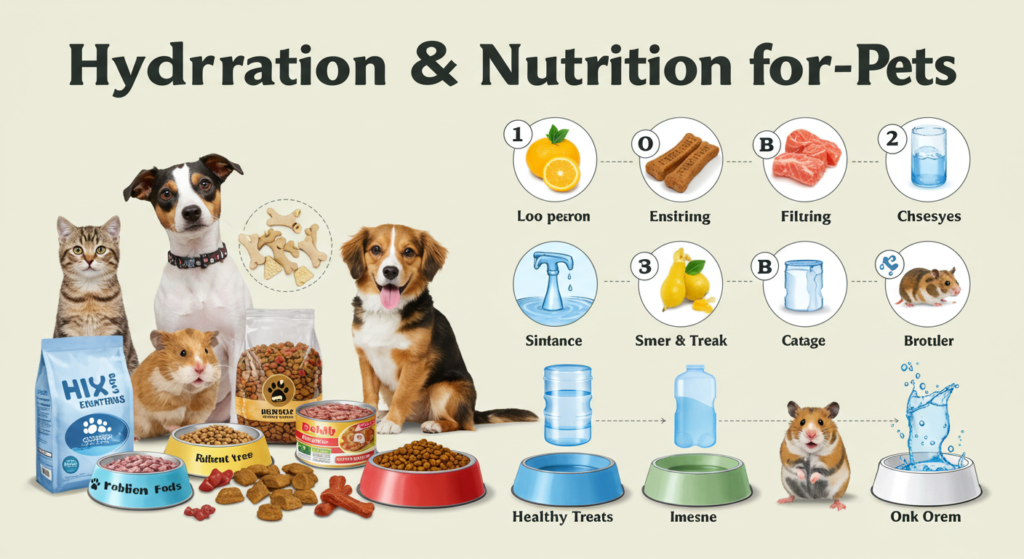Table of Contents
- Introduction
- Importance of Hydration for Pets in Spring
- Recognizing Signs of Dehydration in Pets
- Tips to Ensure Your Pet Stays Hydrated
- Balanced Nutrition for Springtime Energy
- Seasonal Foods and Treats for Pets
- Conclusion
- FAQs
Introduction
As spring arrives and temperatures rise, pet owners need to pay extra attention to their furry companions’ hydration and nutrition. Warmer weather means more outdoor activities, which can increase the risk of dehydration and energy depletion in pets. This article provides essential tips on keeping your pets hydrated, recognizing dehydration signs, and offering a balanced diet to support their energy levels. Additionally, we’ll explore seasonal foods and treats that are both healthy and enjoyable for your pets.

Importance of Hydration for Pets in Spring
Springtime brings longer walks, playful runs, and more time spent outdoors. While these activities are great for your pet’s physical and mental health, they also increase the need for proper hydration. Water is essential for regulating body temperature, aiding digestion, and maintaining overall health. Without adequate hydration, pets can quickly become dehydrated, leading to serious health issues.
Recognizing Signs of Dehydration in Pets
It’s crucial to recognize the early signs of dehydration to address it promptly. Common symptoms include:
- Dry or sticky gums
- Lethargy or reduced energy levels
- Loss of appetite
- Sunken eyes
- Reduced skin elasticity (gently pinch your pet’s skin; if it doesn’t snap back quickly, they may be dehydrated)
If you notice any of these signs, ensure your pet has access to fresh water and consult a veterinarian if symptoms persist.
Tips to Ensure Your Pet Stays Hydrated
- Always Provide Fresh Water: Ensure your pet has access to clean, fresh water at all times. Change the water frequently to keep it appealing.
- Carry Water During Outdoor Activities: Bring a portable water bottle or bowl when going for walks or hikes.
- Add Water to Food: Mix water into your pet’s dry food or offer wet food to increase their water intake.
- Use Pet Fountains: Some pets prefer running water, so consider investing in a pet fountain to encourage drinking.
- Monitor Water Intake: Keep an eye on how much your pet drinks daily, especially during warmer days.
Balanced Nutrition for Springtime Energy
A well-balanced diet is essential to keep your pet energized and healthy during spring. Focus on providing:
- High-Quality Protein: Supports muscle repair and energy levels.
- Healthy Fats: Provides sustained energy for outdoor activities.
- Vitamins and Minerals: Boosts immunity and overall health.
- Fiber: Aids digestion and keeps your pet feeling full.
Consult your veterinarian to tailor a diet plan that meets your pet’s specific needs based on their age, breed, and activity level.
Seasonal Foods and Treats for Pets
Spring offers a variety of fresh, seasonal foods that can be incorporated into your pet’s diet:
- Carrots and Green Beans: Low-calorie, crunchy snacks that are rich in vitamins.
- Blueberries: Packed with antioxidants and perfect for a sweet treat.
- Pumpkin: Great for digestion and can be added to meals in small amounts.
- Apples (without seeds): A refreshing snack that’s high in fiber.
Always introduce new foods gradually and ensure they are safe for your pet’s species. Avoid foods like onions, garlic, grapes, and chocolate, which are toxic to pets.
Conclusion
Spring is a wonderful time for pets to enjoy the outdoors, but it also requires extra attention to their hydration and nutrition. By ensuring your pet stays hydrated, recognizing signs of dehydration, and providing a balanced diet with seasonal treats, you can help them stay active, healthy, and happy throughout the season. Always consult your veterinarian for personalized advice to meet your pet’s unique needs.
FAQs
1. How much water should my pet drink daily?
The amount varies based on size, activity level, and diet. A general guideline is 1 ounce of water per pound of body weight daily.
2. Can I give my pet ice cubes to cool them down?
Yes, ice cubes can be a fun and refreshing treat, but monitor your pet to ensure they don’t choke.
3. Are there any spring plants that are toxic to pets?
Yes, plants like lilies, tulips, and daffodils can be toxic. Keep them out of reach.
4. Can I feed my pet human food as treats?
Some human foods are safe, like carrots and apples, but avoid toxic items like chocolate, onions, and grapes.
5. How can I encourage my pet to drink more water?
Try using a pet fountain, adding water to their food, or offering ice cubes as a fun alternative.
